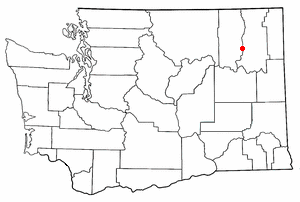Inchelium, Washington
|
|
Inchelium is a census-designated place located in Ferry County, Washington. As of the 2000 census, the CDP had a total population of 389.
Geography
Inchelium is located at 48°18'48" North, 118°13'18" West (48.313214, -118.221681)Template:GR.According to the United States Census Bureau, the CDP has a total area of 68.8 km² (26.5 mi²). 68.7 km² (26.5 mi²) of it is land and 0.1 km² (0.04 mi²) of it is water. The total area is 0.11% water.
Demographics
As of the censusTemplate:GR of 2000, there are 389 people, 153 households, and 95 families residing in the CDP. The population density is 5.7/km² (14.7/mi²). There are 168 housing units at an average density of 2.4/km² (6.3/mi²). The racial makeup of the CDP is 20.31% White, 0.00% African American, 76.61% Native American, 0.00% Asian, 0.00% Pacific Islander, 0.26% from other races, and 2.83% from two or more races. 1.54% of the population are Hispanic or Latino of any race.
There are 153 households out of which 30.7% have children under the age of 18 living with them, 32.7% are married couples living together, 18.3% have a female householder with no husband present, and 37.3% are non-families. 32.0% of all households are made up of individuals and 13.7% have someone living alone who is 65 years of age or older. The average household size is 2.54 and the average family size is 3.31.
In the CDP the population is spread out with 29.6% under the age of 18, 9.8% from 18 to 24, 26.5% from 25 to 44, 23.7% from 45 to 64, and 10.5% who are 65 years of age or older. The median age is 33 years. For every 100 females there are 103.7 males. For every 100 females age 18 and over, there are 110.8 males.
The median income for a household in the CDP is $24,375, and the median income for a family is $42,000. Males have a median income of $37,292 versus $23,194 for females. The per capita income for the CDP is $14,728. 13.4% of the population and 11.0% of families are below the poverty line. Out of the total population, 4.8% of those under the age of 18 and 26.3% of those 65 and older are living below the poverty line.

